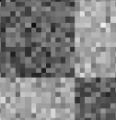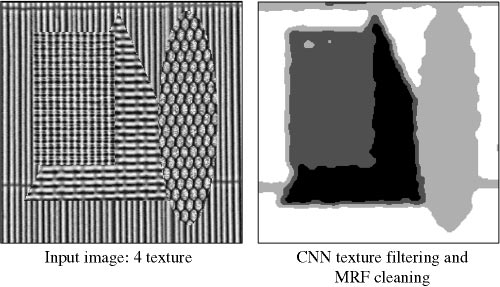You are here
Cellular Neural Networks for Markov Random Field Image Segmentation

Analogical and Neural Computing Systems Lab., SZTAKI (Tamas Sziranyi and Laszlo Czuni)
Pastis Group, INRIA - Sophia Antipolis, France (Josiane Zerubia and David Geldreich)
Statistical approaches to early vision processes need a huge amount of computing power. These algorithms can usually be implemented on parallel computing structures. With the Cellular Neural Networks (CNN), a new image processing tool is coming into consideration. Its VLSI implementation takes place on a single analog chip containing several thousands (recently about 10,000 to 40,000) cells. Every CNN cell is connected to its close neighbors through feedback and feedforward convolutions, and it has an incell dynamics and nonlinearity. CNN Universal Machine (CNN-UM) has been developed for complex image processing tasks. It can be programmed through incell memories and instructions. However, CNN is basically a deterministic analog circuit.
Herein we use the CNN UM architecture for statistical image segmentation. The Modified Metropolis Dynamics (MMD) method can be implemented into the raw analog architecture of the CNN. With a single random input signal, we were able to implement a (pseudo) random field generator using one layer (one memory/cell) of the CNN. The whole algorithm needs 8 memories/cell. We can introduce this pseudo-stochastic segmentation process in the CNN structure. Considering the simple structure of the analog VLSI design, we use simple arithmetic functions (addition, multiplication) and very simple nonlinear output functions (step, jigsaw). With this architecture, a real VLSI CNN chip can execute a pseudo-stochastic relaxation algorithm of about 100 iterations in about 1msec.
In the Makov Random Field (MRF) theory, one important problem is parameter estimation. The random segmentation process must be preceded by the estimation of the gray-level distribution of the different classes on small image segments. This process is basically supervised. Usually the histograms of noisy images can be modelled as simple gaussian distributions. This approach cannot be held in a CNN structure, since there should be as many additional layers as the number of classes. We should follow another way.
We have developed a pixel-level distribution model. The CNN turns the original image into a smooth one using the heat-diffusion equation (Laplace operator) for a given time. Then we have two gray-level values for every pixel: the original and the smoothed one. If the pixel is inside a region, the smoothed value is a good estimation of the unnoisy gray-level of the image. If the pixel is on the border of a region, then the best estimation is between the original and the smoothed values. The probable mean is half the way between the two values, while the variance is the halfwidth of their distance. Furthermore, the probable gray-levels of the different classes can be estimated using the histogram of the smoothed image. The histogram peaks of this cleaned but unsharp image correspond to the gray-level means of the classes. Using this automatic estimation, we can avoid the supervised method.
Using the conventional first-order MRF model, some misclassification errors remained at the region boundaries, because of the estimation difficulties in case of low SNR. Using a larger neighborhood (3-rd order MRF), this problem has been avoided.
In our CNN experiments, we used a simulation system with a fixed-point integer precision of 16 bits. Our results show that the very constrained conditions of value-representations (the interval is (-64, +64), the accuracy is 0.002) can result in an effective and acceptable segmentation.
Our model has been checked on a few synthetic and real data (satellite and medical images). These experiments show that our approach of raw computing and pixel-level distribution estimation is usable for difficult segmentation problems.
Results
Multiscale MRF segmentation: (a) Air view of a scene at Rio Grande, New Mexico with river, bridge, forest, green area and town; segmented into: (b) 3 classes, (c) 4 classes.


